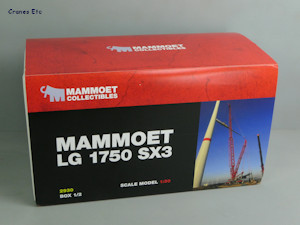 |
| Box 1 of 2.
|
 |
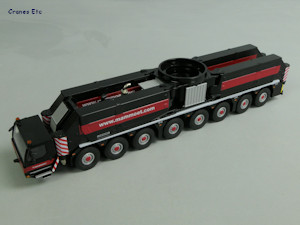 |
| The massive
carrier. |
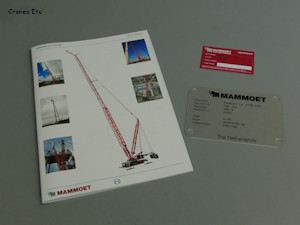 |
| Large manual and
metal Collector's plate.
|
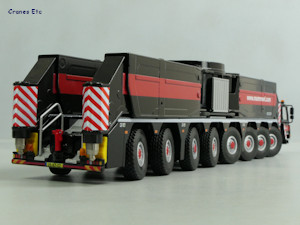 |
| Massive outriggers.
|
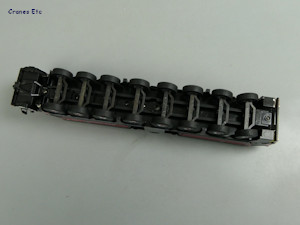 |
| Basic underneath.
|
|
|
 |
| Boom foot on a
trailer. |
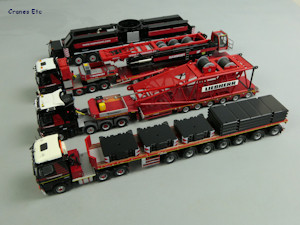 |
| Interesting convoys
can be formed if you have the trucks.. |
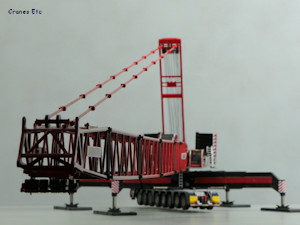 |
| Boom assembled.
|
 |
| Tilting cab.
|
 |
| Heavy lattice sections.
|
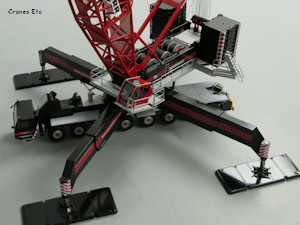 |
| The outrigger beams
are very strong. |
 |
| Impressive posed
with a load. |
 |
| Wide SX boom sections.
|
 |
| De-rigged for an
onsite move. |
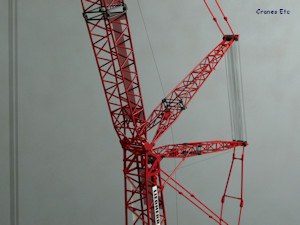 |
| Luffing jib
struts. |
 |
| Rigged with a luffing
jib. |
|
The Liebherr LG 1750 is a high capacity mobile crane with
a lattice boom and jib.
This SX version includes wider boom sections which stabilises
the crane and allows higher and heavier lifts. It
is particularly suited to the wind turbine industry.
This model is in the colours of Mammoet, the Dutch lifting
and heavy haulage specialist.
Packaging
The model comes in two large boxes, on of which is very
heavy. The style of the boxes is the same consisting
of sleeves which wrap three trays.
There were no defects on the review model. However,
there were missing parts which were quickly supplied by
the Mammoet Store.
No information is provided about the real crane, but a 48
page manual is included. It has photos of the box
trays with parts annotated so they can be identified during
the assembly process. All of the many possible configuration
types are shown in outline with detailed instructions for
two of them.
The instructions are a series of staged photographs with
the components at each stage identified. The reeving
diagrams are not the easiest to use and there are some errors
in the pins to be used. Also the manual is really
two manuals joined together. One part is the original
model manual and the second deals with the new SX configuration.
A more integrated and updated manual would have given a more professional
feel.
The manufacture of the parts is to the usual Conrad high
standard and tolerances so it fits together well.
Rope is provided on reels and this has to be wound onto
the relevant drums on the model. All of the plastic
pins have to be broken off of moulding sprues and this takes
quite some time.
A standard Mammoet Collector Card is included and a particularly
nice touch is that there is also a numbered metal Collector's
Plate.
Detail
The carrier is a very heavy model in its own right, with
very little plastic used. Underneath there is no detail
on the chassis with all modelling for functionality only.
The same hub design is used on all wheels with the tyres
having a very heavy tread pattern and branding in the sidewalls.
The driving cab includes a towing hitch, windscreen wipers,
unsilvered mirrors and orange beacon lights. The headlights
inset into the bumper are represented nicely and there are
realistic number plates.
The outrigger beams are huge and are fully made of metal.
They have details within the castings which are good representations
of the original machine. The outrigger beams are controlled
by hydraulic cylinders and whilst the cylinder jackets are
plastic, they have a good colour match, but there are no
hydraulic lines detailed. At the ends, the pistons
are represented authentically with smooth surfaces, and
they bear down on separate large plastic pads. A set
of very large spreader plates is included.
Behind the cab, the deck has a diamond patterned texture
throughout. The engine block has a radiator grille,
and there is a chrome exhaust pipe. At the pedestal
there are ladders which lead to the slewing ring, and on
the outside edges there is a plastic diamond patterned plate
on each side which are stored vertically during transport.
At the rear of the carrier there are steps and handrails
up to the deck, and there are a pair of orange beacon lights,
painted light clusters and a number plate.
The crane body has a swing away cab which includes a walkway,
handrails, wipers and mirrors. Inside, the cab has
a representation of controls and screens. The crane
body has detail within the casting representing panels and
handles, and there are a couple of ladders. At the
front, the three slewing motors look realistic, although
there are no hydraulic lines modelled.
Moving to the rear, the engine enclosure includes textured
surfaces and grilles and a metal exhaust pipe. The
grille detail also extends to the underside of the body.
Heavy ballast trays hang off each side at the rear.
The hoist drums would have looked better in black rather
than grey. Metal platforms with handrails fit to both
sides of the crane body although they are large 'L-shaped'
pieces which cannot be used as a transport load. An
upgrade on this version of the model is the access staircase.
At the crane body, spring loaded back stops prevent the
boom and derrick from over luffing and these parts are all
metal. All of the pulleys are metal, and are free
rolling.
The boom and jib sections are geometrically perfect, and
they fit together extremely well. They have clip-on
mesh walkways. The sections are joined together by
the usual Conrad plastic pins which mostly work reasonably
well, but some in some places are too tight and in others
are too loose. They can also be very difficult to remove
when altering the configuration.
The Mammoet colour scheme is represented with the ends of
the sections being black, and with black fixing bolts.
The black ends appear to be formed by dipping fully red
painted sections into black plate. However, in some
places it creates some untidiness and the black paint easily
rubs off as it appears to not bond well over the red paint.
This version of the model includes the parts to fabricate
three SX boom sections. The metal parts are well made
with additional plastic internal bracing and white cross
beams not quite as good. The sections look very good
when built up.
Two wind jib heads are included with one a new tooling.
They match the other sections well.
For the luffing jib configuration the luffing bridles are
plastic, presumably to keep the weight of these parts down
so that the lines do not sag unduly. Another plastic part
is the pulley holder on the main boom head and this would
certainly have been better in metal like the luffing jib
head, which is a heavy piece. Liebherr signboards
are fixed to the boom and jib.
The counterweight tray pins to the back of the crane and
has a textured walking surface and nicely rendered metal
handrails. Ladders descend to the support bed, and
the support mechanism is detailed within the casting, but
the cylinders are non functioning. The counterweight
slabs have useable lifting points.
The model generally lacks appropriate tying-off points which
means that untidy improvised solutions are necessary.
Four hooks are provided. Two consist of the same modular
components They strip down to separate pulley block
and hook assemblies with only the pulleys and pins being
plastic. Also included is a special block for the
large wind head configuration. A single line hook
is also included but it is too small for the size of the
crane.
Other parts are included in the set which are not referenced
anywhere in the manual. This includes two parts (D2
and D3) which may be boom erection supports.
Features
The steering on the carrier is good with
each axle being independently steerable.
The outrigger beams pull out laterally from the carrier
and can be telescoped out to maximum extension. It
is also possible to pose the model with shortened outrigger
beams like the original. There does not seem any easy
way to remove the outrigger beams to enable the beams to
be transported on a separate vehicle. On both outside
edges of the carrier between the outriggers are plastic
diamond patterned plates which fold down to provide a platform.
These work but are a very tight fit so some care is needed
to prise them open.
The crane fits into the slewing ring on top of the carrier
and clips into place. There is a 'button'
inside the crane which, when pressed, releases the catches
and allows the crane to be detached from the carrier.
Although the mechanism seems a little lightweight, it held
the crane under all load conditions during the review, some
of which were testing. The crane can be carefully
rotated when assembled.
The crane cab is a swing away type which tucks in at the
front when in transport mode. It can also be tilted
slightly to allow the operator comfort when the crane is
lifting at height.
All three hoist drums in the crane body are resistant to
slipping under load. They are operated using detachable
winch handles which push through holes in the crane body
and they have a slotted end so they can be driven using
a powered screwdriver. The three hoist drums mounted
in the boom and derrick sections are operated similarly
so that all the functions of the real crane can be replicated.
There is also a small auxiliary hoist drum at the front
of the crane by the slewing motors.
The access stair can be lowered, or raised for when the
crane is operational.
The counterweight tray is extendible and has notches which
produce three different extension radii.
The main feature of the model is the vast number of possible
configurations that can be built and in that sense it truly
replicates the real crane. The parts also allow it
to be used to make up a large number of transport loads.
Quality
The model engineering is very good and robust,
and it is a sturdy crane when built up. It fits together
well. Some aspects show the underlying age of the
original model and the plastic bolts and pendants are not
to the best of modern standards.
Paintwork and graphics are mostly fine.
Price
This is a costly crane model although you
do get an unrivalled set of configuration possibilities
including a version approaching 4m tall..
Overall
This is a hugely impressive model set which
allows numerous ways to assemble a very impressive model.
The model is robust and looks strong.
With that said it would have been nice to have seen some
further improvements to the underlying earlier version
in order to make it a flagship model.
To summarise, the options to build the model many
different ways give huge display flexibility, and all in
all it looks
very good.
Footnotes
The model first appeared as
a prototype at the Nuremberg Toy Fair in February 2007.
This version of the model was announced at the Nuremberg
Toy Fair in 2024 and appeared in July 2024. The production
run was 750 models.
|
|
 |
|
|
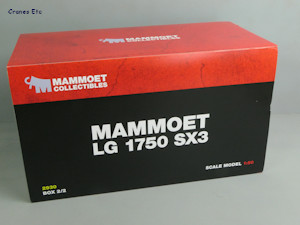 |
| Box 2 of 2. /td>
|
 |
| Steering on each
axle. |
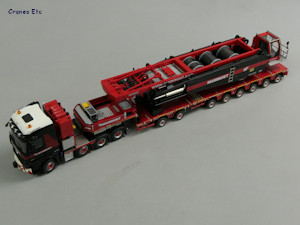 |
| The crane on a
low trailer. |
 |
| Smart Mammoet livery.
|
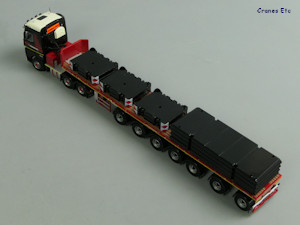 |
| Plenty of parts
can be used as loads.. |
 |
| The model can be
posed 'wheels-free'. |
|
|
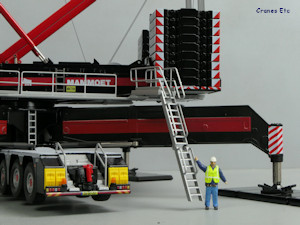 |
| Access stair can
be lowered. |
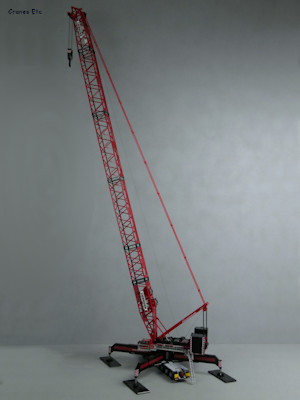 |
| The crane is rigged
with a main boom only. |
 |
| Rigged with a derrick.
|
 |
| Floating counterweight
tray hangs from the derrick. |
 |
| Rigged for wind
turbine work. |
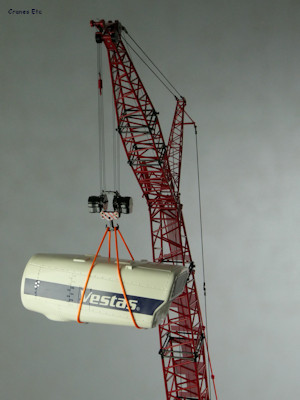 |
| Lifting a nacelle.
|
 |
| Impressive heights
can be achieved. |
 |
| Lifting a heavy
bridge beam. |
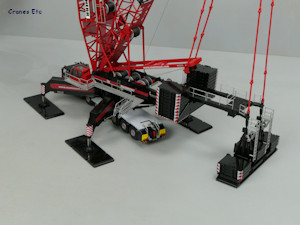 |
| Heavy lifting
set up. More counterweights can be added to the
tray. |
|

